In an exciting archaeological development, ground-penetrating radar (GPR) scans conducted on September 14, 2023, may have finally located the long-lost grave of George Gilpin, a Revolutionary War hero and one of Alexandria’s most influential early citizens. This discovery of George Gilpin’s presumptive grave not only solves a historical mystery but also provides us with an opportunity to revisit the remarkable life of this unsung hero of early American history.
George Gilpin (1740-1813) is an unsung hero of early American history whose life story intertwines with the very fabric of the nation’s founding and the development of Alexandria, Virginia. Though his contributions were immense, Gilpin’s legacy has been overshadowed by time. This blog will explore Gilpin’s multifaceted life, including his military service alongside George Washington, his role in shaping Alexandria’s landscape as a surveyor and urban planner, his contributions to regional commerce through the Potomac Company, and his close connections to America’s founding fathers.
A Life of Service and Leadership
George Gilpin’s life was marked by an unwavering commitment to public service and a remarkable range of accomplishments. Born in 1740, Gilpin would go on to play crucial roles in both military and civic affairs during America’s formative years.
Even before the outbreak of the Revolutionary War, George Gilpin demonstrated his commitment to the cause of American independence. In 1774, he was one of the 25 signatories of the Fairfax Resolves, a set of resolutions adopted by the Fairfax County Committee of Virginia on July 18, 1774. These resolves, largely written by George Mason with input from George Washington, outlined the colonists’ constitutional rights and denounced British actions against Boston. Gilpin’s signature on this document places him among the early advocates for colonial rights and demonstrates his political engagement at a crucial moment in American history.
During the Revolutionary War, Gilpin stood shoulder-to-shoulder with George Washington, fighting in pivotal battles such as Dorchester Heights, the New Jersey Campaign, and Germantown. His military prowess was matched only by his civic engagement, as he served on the Fairfax Committee of Safety and in the Fairfax Militia.
Shaping Alexandria’s Landscape and Commerce
George Gilpin and the Banking Out of Alexandria
One of Gilpin’s most significant contributions to Alexandria’s development came through his role in overseeing the dramatic transformation of the city’s waterfront, a process known as “banking out.”
As Fairfax County Surveyor, Gilpin supervised the expansion of Alexandria’s usable land by filling in the shallow parts of the Potomac River along the town’s crescent-shaped bay. This process, undertaken by waterfront property owners, involved knocking down 15-20 foot high bluffs and using the material to create wharves extending to the river’s deep channel.
Under Gilpin’s guidance, this massive project was completed by 1798, significantly altering Alexandria’s landscape. The “banking out” process expanded the city’s commercial capabilities, improved its infrastructure, and set the stage for Alexandria’s future as a key port city.
Gilpin’s 1798 map of Alexandria, shown below, captures the results of this transformation and stands as a testament to his meticulous work and intimate knowledge of the area’s geography.

The map clearly shows the expanded waterfront area resulting from the “banking out” process, illustrating the dramatic changes Gilpin had overseen. It captures a pivotal moment in the city’s history, showcasing the results of the “banking out” process and the expanded waterfront that would prove crucial to Alexandria’s commercial development.
Interestingly, the publication of this map has its own story. John V. Thomas, publisher of the Alexandria Times And District Of Columbia Daily Advertiser, arranged for its engraving and publication. Thomas had to place an amusing advertisement in the Advertiser on September 26, 1797, requesting the return of Gilpin’s original drawing, which he had lent to an acquaintance and couldn’t recall who had borrowed it.
The map was eventually engraved by Thomas Clarke of New York City, and its publication was announced in the December 4, 1799 issue of the Advertiser, priced at $1.50. Remarkably, the copper printing plate survived into the 20th century and was acquired by Mangum and Josephine Weeks of Alexandria. In 1944, they commissioned a limited edition restrike of 165 impressions, likely commemorating the 150th anniversary of the Alexandria Library’s founding.
Original 18th-century impressions of this plan are extraordinarily rare, with known copies only at the Library of Congress and the Albert Small Collection at George Washington University. The map’s inclusion in significant cartographic bibliographies underscores its historical importance and Gilpin’s lasting impact on our understanding of early American urban landscapes.
(Source: Boston Rare Maps, https://bostonraremaps.com/inventory/1798-george-gilpin-alexandria-virginia/)
Did You Know?
George Gilpin’s expertise in surveying played a crucial role in Alexandria’s early development beyond just urban planning. He surveyed The Spring Garden Farm, which was intended to be one of Alexandria’s first subdivisions. Gilpin meticulously plotted the lots for buyers and laid out the streets, including Mandeville Lane and Hamilton Avenue.
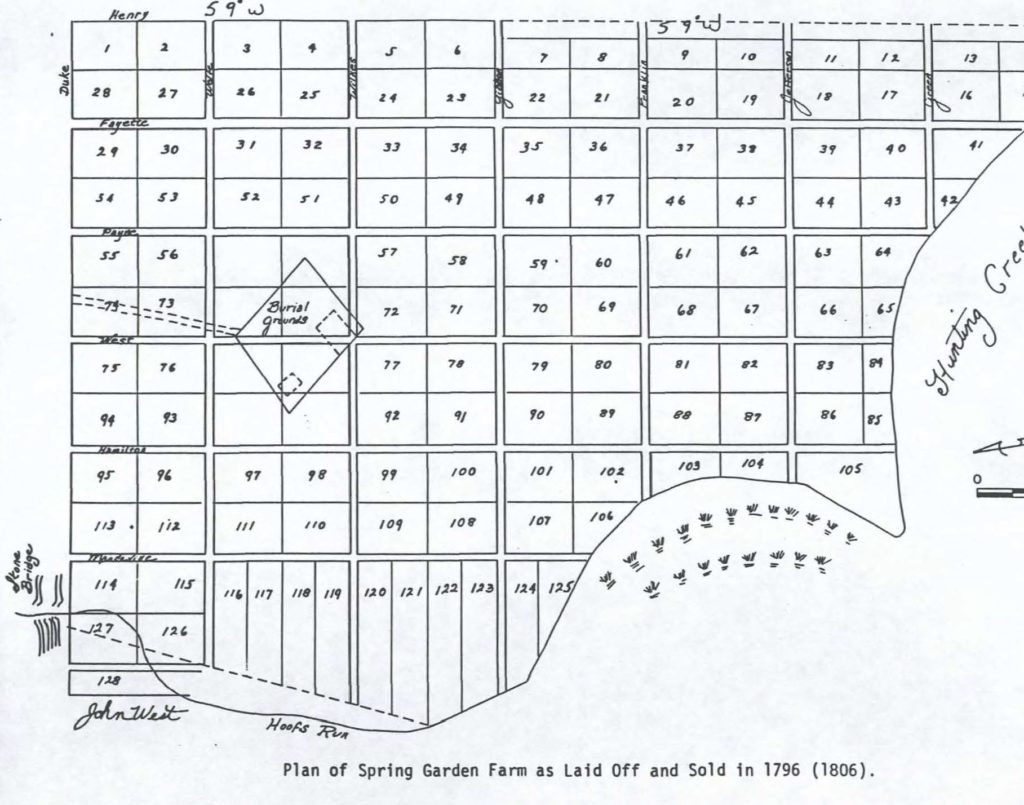
This plan represents a fascinating moment in Alexandria’s expansion, showcasing Gilpin’s vision for the city’s growth. While the Spring Garden subdivision didn’t materialize as planned, the streets Gilpin laid out became integral to the Wilkes Street Cemetery Complex. In a poignant twist of fate, Gilpin’s own burial plot now lies near the intersection of Hamilton and Wilkes Street, on land he once surveyed for a very different purpose.
The presence of Hamilton and Mandeville Lane at the bottom of the map provides a direct visual link to the present-day cemetery complex, allowing us to see how Gilpin’s work continues to shape Alexandria’s landscape more than two centuries later.
This map not only highlights Gilpin’s skills as a surveyor and urban planner but also provides a tangible link between his professional work and his final resting place, adding another layer to his enduring legacy in Alexandria’s history.
The Potomac Company: George Gilpin’s Vision for Regional Commerce
Building on his experience with Alexandria’s waterfront, Gilpin’s impact extended beyond the city’s borders through his involvement with the Potomac Company.
Gilpin’s impact extended beyond Alexandria’s borders through his involvement with the Potomac Company. Founded in 1785, this ambitious project aimed to improve the navigability of the Potomac River for commerce. As a director, Gilpin worked closely with George Washington, who served as the company’s first president. This collaboration further strengthened the bond between these two influential figures, extending their relationship from military comrades to partners in regional development.
The Potomac Company’s goal was to construct a series of canals designed to bypass rapids in the river, opening up trade routes from the Chesapeake Bay to Cumberland, Maryland. Gilpin’s expertise as a surveyor and his intimate knowledge of the region made him an invaluable asset to the project.
Gilpin was not alone in recognizing the potential of this project. Many prominent Alexandrians invested in the Potomac Company, seeing it as key to the city’s future prosperity. Among these investors was Philip Richard Fendall, Sr., a notable figure in Alexandria’s history. Fendall, who lived in what is now known as the Lee-Fendall House on Oronoco Street, shared Gilpin’s vision for improved river navigation and commerce.
Despite numerous challenges, including labor shortages and financial struggles, the company completed several important canals. The most well-known, the Great Falls skirting canal, remains visible today as part of Great Falls Park, a testament to the vision and engineering prowess of Gilpin and his contemporaries. A skirting canal is a type of canal that bypasses difficult sections of a river, such as rapids or waterfalls, to allow boats to navigate more easily.

The Great Falls of the Potomac, which the skirting canal was designed to bypass, is a series of cascading waterfalls located about 15 miles northwest of Washington, D.C. Here, the Potomac River builds up speed and force as it falls over a series of steep, jagged rocks and flows through the narrow Mather Gorge. The falls drop a total of 76 feet over a distance of less than a mile, creating a spectacular sight but also a formidable barrier to river navigation. This natural obstacle necessitated the construction of the skirting canal, allowing boats to safely continue their journey up or down the river without risking the dangerous falls.
While the Potomac Company’s efforts were ultimately superseded by the Chesapeake and Ohio Canal, they represented an important step in the development of American infrastructure and laid the groundwork for future transportation innovations in the region.
Interestingly, John Mason, son of George Mason IV and the last president of the Potomac Company, is buried almost directly across from Gilpin in the Christ Church Cemetery. This proximity in death mirrors their connection in life through their shared vision for improving navigation and commerce along the Potomac. Mason’s involvement in the Potomac Company, like Gilpin’s, demonstrates the commitment of Alexandria’s leading citizens to regional development and prosperity. You can read more about John Mason at this [link].
George Gilpin’s Close Connection to the Founding Fathers
Gilpin’s proximity to the nation’s founding fathers is evident in several key moments of his life. A significant example is his attendance at the laying of the cornerstone of the U.S. Capitol Building on September 18, 1793.
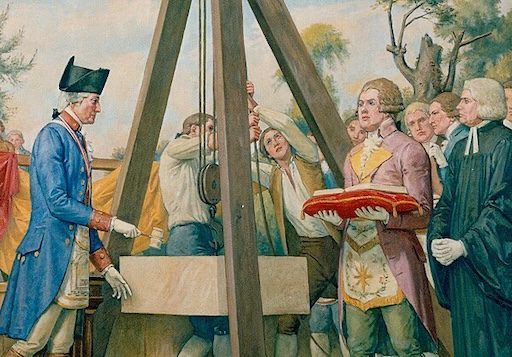
This image depicts a portion of a larger mural by Allyn Cox illustrating the laying of the United States Capitol cornerstone by George Washington. The mural is located in the Cox Corridors of the U.S. Capitol building, specifically in the Hall of Capitols on the first floor of the House wing. This corridor features paintings of 16 different buildings that housed the Continental and United States Congresses from 1754 to 1865, with eight historic events painted in the barrel vaults of the ceilings.
The Capitol’s first cornerstone was laid on September 18, 1793, by President Washington in a Masonic ceremony. The event was preceded by a parade and followed by celebration and feasting. George Gilpin was among the distinguished attendees at this historic event. Standing on the far right side of the image is Reverend James Muir, D.D., who was at the time the pastor of the Presbyterian Meeting House in Alexandria, VA (later part of D.C. between 1801 and 1847).
This identification was confirmed by the artist Allyn Cox in correspondence with Mary Lloyd (Mrs. Laurence G.) Fawcett (1904-1970), a Women of the Church historian at the Old Presbyterian Meeting House and assistant at the Alexandria Library. Fawcett worked at what is now known as the Kate Waller Barrett Branch on Queen Street, contributing to preserving Alexandria’s rich history. Her work in the mid-20th century helped to clarify essential details of Alexandria’s early days. Interestingly, Mary Lloyd Fawcett is buried in St. Paul’s Cemetery, part of the same cemetery complex as Christ Church Cemetery, where Gilpin is presumed buried. Despite the centuries between their lives, this proximity in death symbolizes the enduring connections between Alexandria’s historical figures across different eras.
In a remarkable connection to another significant historical event, Muir also officiated at Washington’s funeral. He is now buried 13 feet beneath the north aisle floorboard of the Old Presbyterian Meeting House in Alexandria, VA. As the creator of Gravestone Stories, I’ve dedicated this website to telling the stories of hundreds of Alexandrians buried in local cemeteries through mini-biographies and blogs. I also lead tours of these historic burial grounds, sharing these stories with visitors. My connection to this history is deeply personal – I’ve been a member of the Meeting House for over 60 years, and my family’s pew when I was growing up was located directly over Muir’s grave, albeit 13 feet above it.
The Meeting House, still an active congregation of the Presbyterian Church (USA), maintains this deep connection to the past. Its 18th-century burial grounds, where many notable figures from early American history are interred, offer a tangible link to the nation’s formative years. You can read more about Reverend James Muir at this link.
The presence of both Gilpin and Muir at this ceremony underscores the significant role of Alexandria’s citizens in the nation’s early days and their connection to founding figures like Washington, who is depicted on the left side of the image.
(Source: Architect of the Capitol, https://www.aoc.gov/explore-capitol-campus/art/capitol-cornerstone-ceremony-1793)
The connections between Gilpin, Muir, and Washington extended beyond the Capitol cornerstone ceremony. Gilpin and Muir played significant roles in Washington’s funeral service, further underscoring their importance in early American history. As noted in another blog on this site, the commemorative service for Washington was a solemn and community-wide event. Reverend James Muir participated actively in the service, while George Gilpin served as an honorary pallbearer. They were joined by other prominent Alexandria figures such as Dr. James Craik, Dennis Ramsay, and Charles Simms, among others. This gathering of notable citizens for Washington’s funeral demonstrates the tight-knit nature of Alexandria’s leading figures and their collective reverence for the first president.
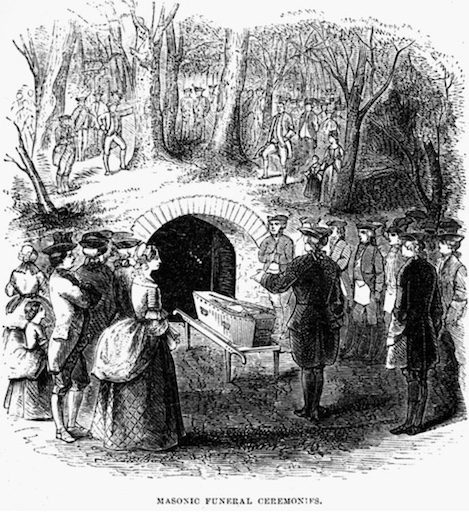
Rediscovering George Gilpin’s Legacy
For years, the exact location of George Gilpin’s final resting place remained a mystery. While a weathered gravestone for Mary Gilpin, known to be kin to George, could be found in Christ Church Cemetery, George Gilpin’s own marker had been lost to time. The discovery of Gilpin’s grave would not only honor his memory but also provide a tangible link to one of Alexandria’s most influential early citizens, offering new opportunities for historical research and preservation.
Interestingly, George Gilpin’s daughter, Maria Gilpin (also known as Mary), born in 1768 in Pennsylvania, was one of ten children that Colonel Gilpin had with his wife Catherine Peters. Maria lived a remarkably long life that spanned nearly a century. She passed away on March 18, 1860, in Alexandria, at the impressive age of 92. Maria’s life, along with those of her siblings, offers a fascinating glimpse into the Gilpin family history, connecting Colonel George Gilpin’s era to the mid-19th century. Her longevity and the fact that she was buried in Alexandria, like her father, underscores the family’s deep roots in the area and their enduring legacy in the community.
The search for George Gilpin’s grave takes on added significance when considering the rich family history it represents, including the long life of his daughter Maria, who witnessed Alexandria’s growth and changes for nearly a century.
While Maria’s life story adds richness to the Gilpin family narrative, the mystery of her father’s exact burial location persisted – until now.
However, in an exciting development, ground-penetrating radar (GPR) scans conducted on September 14, 2024, may have finally located Gilpin’s grave. This discovery, if confirmed, would provide a tangible link to one of Alexandria’s most influential early citizens and offer new opportunities for historical research and preservation.
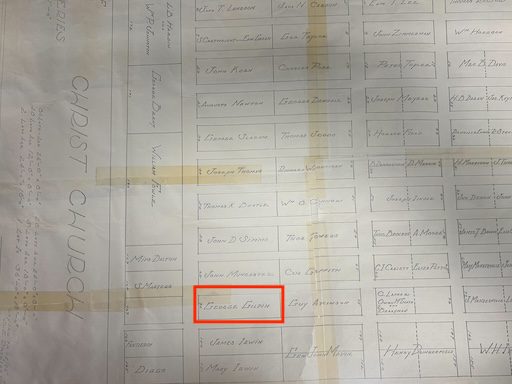
Cemetery (1808) within the Wilkes Street Complex of contemporary and historic cemeteries in Alexandria,
Virginia. The RED RECTANGLE: Noted – Burial plot owned/attributed to (Col.) George Gilpin. Source: Map
attributed to the copyist (Presumptively from an earlier source) D.E. Bayless, Jr., 13 December 1935, and
found in Map Drawer 11 – Alexandria Cemeteries, Alexandria Library, Barrett Branch, Local History Special
Collections, 717 Queen Street, Alexandria, Virginia, 22314.
Below are two images of the presumptive grave of Col. George Gilpin, owner of the cemetery plot number 76. These GPR images represent a significant breakthrough in the search for Gilpin’s final resting place, potentially solving a long-standing historical mystery.
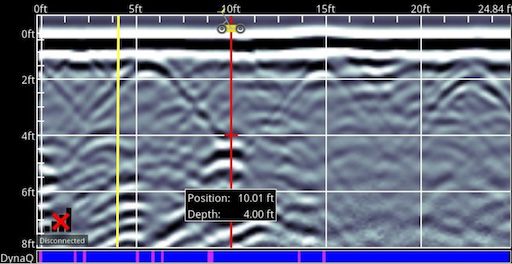
Ground Penetrating Radar (GPR) machine, a Noggin 250 Smart Cart, across/perpendicular to the marked
grave of Mary Gilpin and across the full length of the George Gilpin owned cemetery plot and beyond.
YELLOW VERTICAL LINE: Image of a grave-like anomaly – a grave, which precisely coincides with the mid-
positions of the engraved Mary Gilpin grave headstone and Mary Gilpin engraved (M.G.) footstone. RED
VERTICAL LINE: Image of a grave-like anomaly – a grave, the center line of which is parallel to and c. four
feet (4’) North from the centerline of the Mary Gilpin grave. This is the presumptive grave of Col. George
Gilpin, owner of the cemetery plot number 76. Image by, and modified by, Mark Michael Ludlow RPA, 14
September 2024.
The discovery of Gilpin’s grave not only honors his memory but also provides archaeologists and historians with a valuable opportunity to learn more about burial practices of the era and potentially uncover additional artifacts that could shed light on Gilpin’s life and times.
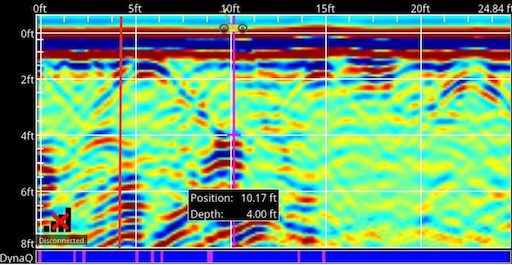
Ground Penetrating Radar (GPR) machine, a Noggin 250 Smart Cart, across/perpendicular to the marked
grave of Mary Gilpin and across the full length of the George Gilpin owned cemetery plot and beyond. RED
VERTICAL LINE: Image of a grave-like anomaly – a grave, which precisely coincides with the mid-positions
of the engraved Mary Gilpin grave headstone and Mary Gilpin engraved (M.G.) footstone. PURPLE
VERTICAL LINE: Image of a grave-like anomaly – a grave, the center line of which is parallel to and c. four
feet (4’) North from the centerline of the Mary Gilpin grave. This is the presumptive grave of George Gilpin,
owner of the cemetery plot number 76. Image by, and modified by, Mark Michael Ludlow RPA, 14
September 2024. Gravesite Location: 38.801792, -77.056827
Remembering George Gilpin: A Multifaceted Leader
George Gilpin’s life serves as a testament to the diverse talents and unwavering dedication of America’s founding generation. From military service to urban planning, from commerce to public administration, Gilpin left an indelible mark on Alexandria and the young nation.
A Lasting Tribute
Today, a plaque near his former residence at 206 King Street commemorates his many roles:
Home of George Gilpin 1740-1813 Member, Fairfax Committee of Safety Colonel, Virginia Regiment Fairfax Militia, Served with General George Washington in New Jersey campaign and Battle of Germantown Surveyor of the Town of Alexandria 1798 then part of the District of Columbia Member of the Alexandria Lodge of Masons Vestryman of Christ Church Honorary Pallbearer to General Washington
As we reflect on Gilpin’s life and the potential rediscovery of his final resting place, we’re reminded of the countless individuals whose dedication and service laid the foundation for the America we know today. George Gilpin’s story is not just a tale of personal accomplishment but a window into the collaborative effort that built a nation.
George Gilpin’s Life: A Timeline of Key Events
To better visualize Gilpin’s journey through history, here’s a timeline of key events in his life:
- 1740: Born
- 1774: Signs the Fairfax Resolves on July 18
- 1775-1783: Serves in the Revolutionary War
- 1785: Becomes a director of the Potomac Company
- 1793: Participates in laying the cornerstone of the U.S. Capitol
- 1798: Oversees the “banking out” of Alexandria as city surveyor
- 1799: Serves as pallbearer at George Washington’s funeral
- 1813: Dies, aged 73
Gilpin’s Grave: History Identified, Recognition Withheld
Despite substantial documentary and physical evidence pointing to this unmarked grave as the final resting place of George Gilpin—a Revolutionary War officer and civic leader—the DAR has stated they do not consider the proof sufficient to warrant a marker at this time. It’s a disappointing stance, given the weight of the historical record. But as more people engage with Gilpin’s story and see the evidence for themselves, recognition feels less a matter of if, and more a matter of when.
Sources of Information
Architect of the Capitol. (n.d.). Capitol Cornerstone Ceremony, 1793. Retrieved from https://www.aoc.gov/explore-capitol-campus/art/capitol-cornerstone-ceremony-1793
Bayless, D. E., Jr. (1935, December 13). [Map of Alexandria cemeteries]. Alexandria Library, Barrett Branch, Local History Special Collections, Map Drawer 11, Alexandria, VA.
Boston Rare Maps. (n.d.). Plan of the town of Alexandria in the District of Columbia, 1798. Retrieved from https://bostonraremaps.com/inventory/1798-george-gilpin-alexandria-virginia/
City of Alexandria. (n.d.). Archaeology at the Hotel Indigo Site. Alexandria Archaeology Museum. Retrieved from https://www.alexandriava.gov/archaeology/archaeology-at-the-hotel-indigo-site
City of Alexandria. (n.d.). Extending the shoreline: Bulkhead & wharves. Alexandria Archaeology Museum. Retrieved from https://www.alexandriava.gov/archaeology/basic-page/extending-shoreline-bulkhead-wharves
City of Alexandria. (n.d.). Historic cemeteries of Alexandria. Alexandria Historic Sites. Retrieved from https://www.alexandriava.gov/historic-sites/historic-cemeteries-of-alexandria
Dahmann, D. (personal communication dated September 18, 2024). Information about Allyn Cox’s correspondence with Mary Lloyd Fawcett regarding the identification of Rev. James Muir in the U.S. Capitol cornerstone laying mural.
FamilySearch. (n.d.). Colonel George Gilpin (1740–1813). https://ancestors.familysearch.org/en/L28Y-FFT/colonel-george-gilpin-1740-1813
Gardner, W. M., Snyder, K. A., Hurst, G., Walker, J. M., & Mullen, J. P. (1999). Excavations at the Old Town Village Site, corner of Duke and Henry Streets, Alexandria, Virginia: An historical and archeological trek through the 200-year history of the original Spring Garden development [Report prepared for Eakin and Younentob]. Alexandria, VA.
Ludlow, M. M. (2024). Finding the Burial Place with Ground Penetrating Radar (GPR) of Col. George Gilpin (1740 to 1813 – Age 73), American Revolutionary War, With George Washington at Valley Forge, Pennsylvania & A Distinguished Citizen of Alexandria, Virginia. Unpublished manuscript.
Mount Vernon Ladies’ Association. (n.d.). The Potomac Company. George Washington’s Mount Vernon. Retrieved from https://www.mountvernon.org/george-washington/the-potomac-company
Pippenger, W. E. (1992). Tombstone inscriptions of Alexandria, VA (Volume 3). Family Line Publications.
The Alexandria Association. (1956). Our town 1749 – 1865. The Dietz Printing Company.
Washington Post (20 February 1955), Washington Star (20 February 1955), Letter from Cox to Willingham dated 7 July 1955 in Scrapbook II, Old Presbyterian Meeting House archives.
Wikipedia contributors. (n.d.). Patowmack Canal. Wikipedia. From https://en.wikipedia.org/wiki/Patowmack_Canal